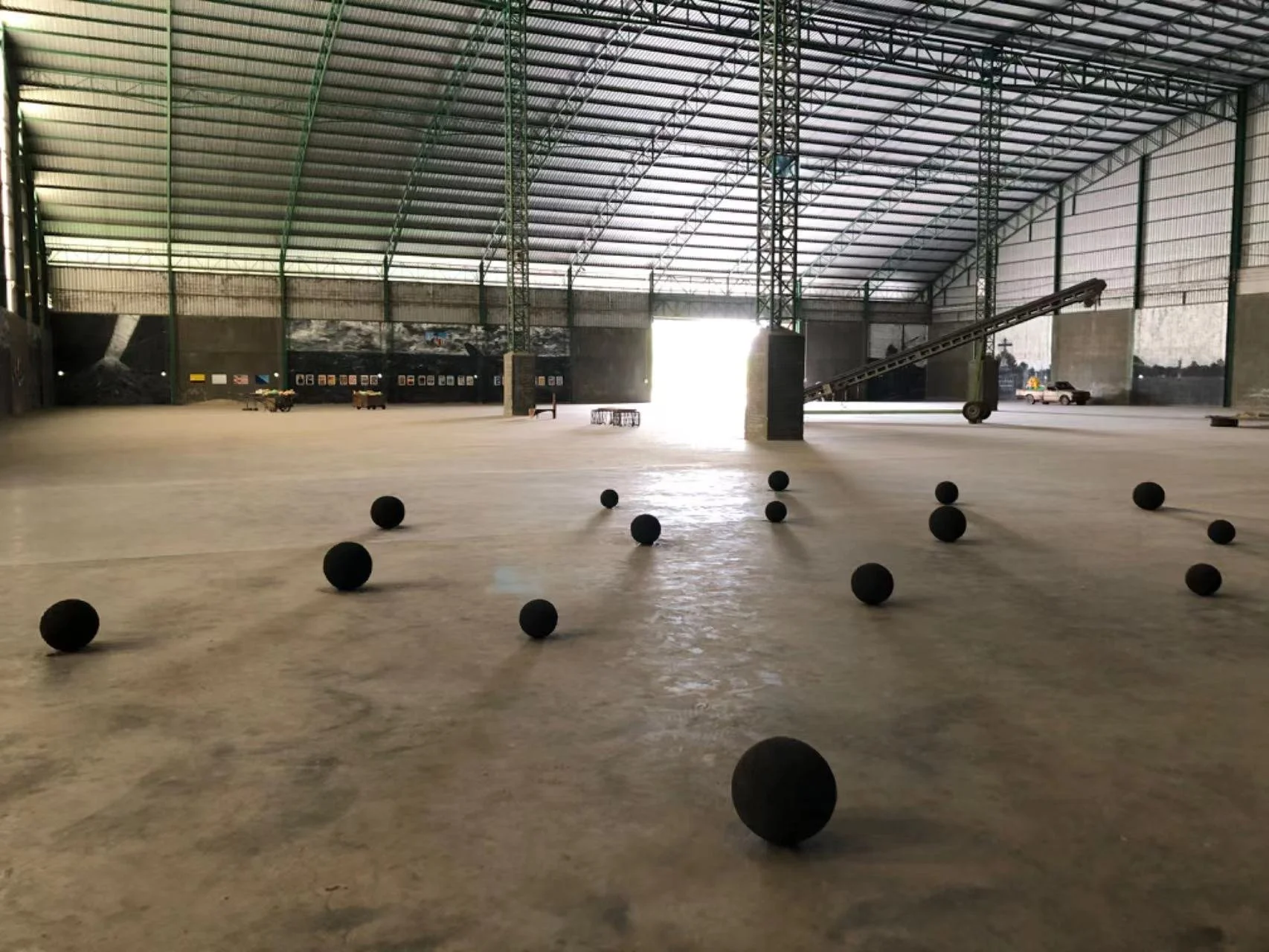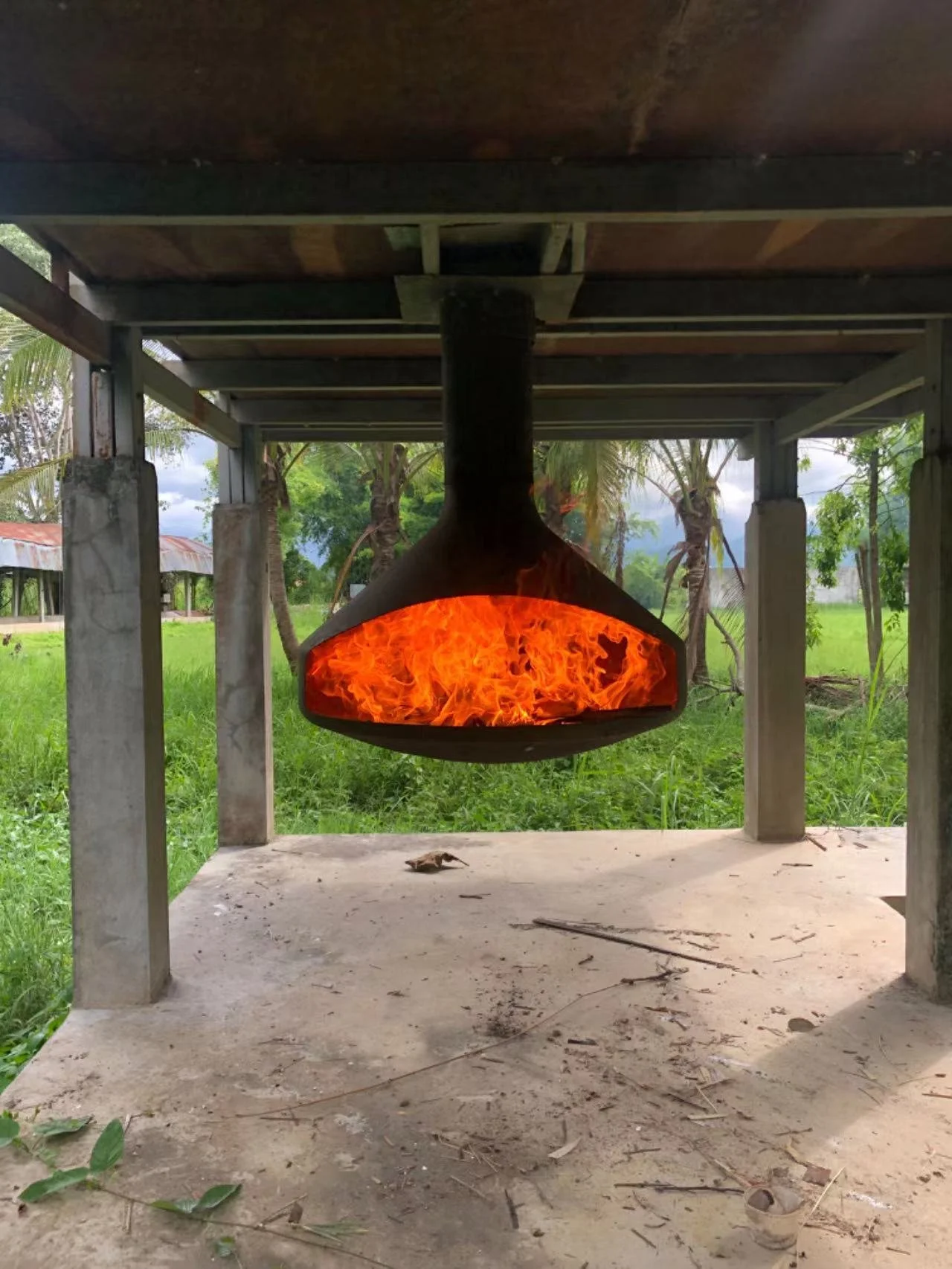Cockroach NIMBY: Outdoor Curating in Thailand
Preecha Raksorn and Gallery 1984+1
Trinnapat Chaisitthisak, Memorial of Dust, 2023, rice husk charcoal, dimensions variable, exhibition view at Gallery 1984+1, Suphanburi, Thailand. Image courtesy of Ariana Chaivaranon.
In 1948, a man named Pachan Raksorn founded a rice mill on the banks of the Tha Chin river in Thailand. Pachan passed the business down to his son, Chugit Raksorn, and grandson, artist and curator Preecha Raksorn, who started an art space on the property. The mill’s refurbished office and storage area now house Preecha’s living quarters, studio, and Gallery 1984+1. Since mill operations ceased in 2021, the original four-storey wooden structures and old machinery have remained largely untouched.
Preecha invites the artists who exhibit in Gallery 1984+1 to create work in dialogue with the rice mill and surrounding area. This is what brought me to the site. I visited the location cloaked in a heavy, humid darkness that was punctuated only reluctantly by Preecha’s flashlight. The dense lace of scaffolding, walkways, and staircases extended and ascended into the night. As we walked deeper into the mill, our conversation about techno raves, theatre, and art installations finally cracked to address the elephant in the room: the cockroaches.
The mill’s wooden beams quivered with thousands of glimmering sienna scales. Roaches ran toward my feet, then scattered. As I hopped from foot to foot, my mind clouded with panic. How could such a place become sanitary and safe for visitors? Would the art get eaten? Will I get eaten? It was only in the car home that my fear subsided to a gnawing shame. I had shown disgust as a guest in Preecha’s home.
“How could such a place become sanitary and safe for visitors? Would the art get eaten? Will I get eaten? It was only in the car home that my fear subsided to a gnawing shame. I had shown disgust as a guest in Preecha’s home.”
***
Years earlier, I was starting my first job at the National Gallery of Art in Washington DC. The climate-controlled conservatory was the highlight of my orientation tour. This massive in-house greenhouse grows all the plantings and florals for museum events, ensuring that no art-threatening pests hitch a ride into the galleries. My neurotic brain exhaled in relief at the fact that in this sanctuary for art, every nonhuman breath was perfectly under control. Or, from another angle, smothered.
Control is costly. In the face of scarce financial resources, gatekeeping curators are like New York’s NIMBY homeowners who exacerbate an escalating housing crisis in a city with limited affordable stock. Well-meaning citizens raise the baseline cost of housing by demanding that new stock have “basic amenities”, like in-unit bathrooms and kitchens, even though many unhoused people would take an apartment with no kitchen over sleeping in their cars. Similarly, many artists would rather show in spaces open to insects than let the work rot in the studio.
In addition to the economic accessibility, many artists like Preecha see exhibition sites like the rice mill as an opportunity. As an organiser for upcoming exhibitions at Chiang Mai’s Land Foundation, I recognise that the relative remoteness and open-air structures of the site are deal-breakers for some. Others, however, regard the insects who will make homes in their works and the farm animals that Mit Jai Inn plans to raise there as meaningful audience segments. Faced with this radical re-imagining of who art is for, I can’t help but wonder if the ticketed institution’s framing of audience is impoverished by comparison. Chaotic spaces like the Land Foundation and rice mill situate art in a polyphonous dialogue with the world that cannot be replicated in a sealed white cube.
Fireplace on the ground floor of Tiravanija’s House at the Land Foundation, Chiang Mai, Thailand. Image courtesy of Ariana Chaivaranon.
***
The project of activating and reigning in remote, un-electrified, outdoor spaces already teeming with Wild Life is a beast. It is easier to turn down the offer entirely and tell artists: “You deserve better.” But this approach denies artists the opportunity to rise to the challenge. In an unjust [art]world, where well-deserved resources are endemically denied to those “outside”, curators should explore possibilities rather than declare ultimatums. I will never stop fighting to get artists what they deserve. Working in Thailand, however, forces me to invite artists into the process of transfiguring these fixer-uppers into spaces that work for us.
The comfort of climate-control is as irresistible as it is paradoxical amid global climate extinction. Would Tazeen Qayyum be interested in making a site-specific installation using her cockroach motif for the rice mill, as she did for the 2022 Bangkok Art Biennale? Would Max Hooper Schneider be laissez-faire about river roaches highjacking his “ecologies of neglect”1 as was he was with a mouse dying in a sculpture for the Hammer Museum?²
Most of the works that bring us wisps of “nature” in life-smothering spaces were not made to stand their ground in the organic chaos of the world outside. How many visitors would choose to risk their white-soled shoes, or even their health, in the Suphanburi rice mill? Should curators shelter them from facing an invitation into the daily realities of the many? The Tate Modern’s stanchions around Ai Weiwei’s Sunflower Seeds (2010) barred visitors from sharing a fraction of the toxicity endured by Jingdezhen ceramicists. But in Thailand, rivers flood, roaches fly, and traditional architecture is open-air. The fantasy of drawing a border between one’s bodily sanctum and the life beyond requires money and disdain, duplicating the colonial hegemony that segregated “outside” from “inside” in the first place.
In my own Chiang Mai home, we hired an exterminator. I skittered off to white-walled MAIIAM to let the roaches die in peace. As I counted their bodies, I prayed to an archival-framed photo of Khru Ba Sriwichai to shepherd the remaining roaches away from my apartment. I’m a cockroach NIMBY, a vegetarian, a Thai-American hypocrite. I lead harm-reduction workshops for museums and pay for pest control. But I moved home to Thailand, away from the sanitised American art museum, because there is something alive in the loam here that will explode the boundaries of the art world if we curators can learn that ancient dance between control and chaos: cultivation.
Maybe my work here will make it possible for great art to be exhibited with integrity in places like the Suphanburi rice mill. Maybe I will enjoy it when I’m reborn as a cockroach. Maybe you will come visit me.
The views and opinions expressed in this article are the author's own and do not necessarily reflect those of A&M or the prize sponsors.
This is a winning entry from the fourth Art & Market ‘Fresh Take’ writing contest. For the full list of winners and prizes, click here.
Notes:
Beau Rutland. “1000 Words: Max Hooper Schneider,” Artforum. January 2016.
Kate Wolf, “Max Hooper Schneider’s Sculptures May or May Not Include a Dead Mouse,” Interview Magazine, September 9, 2019.


